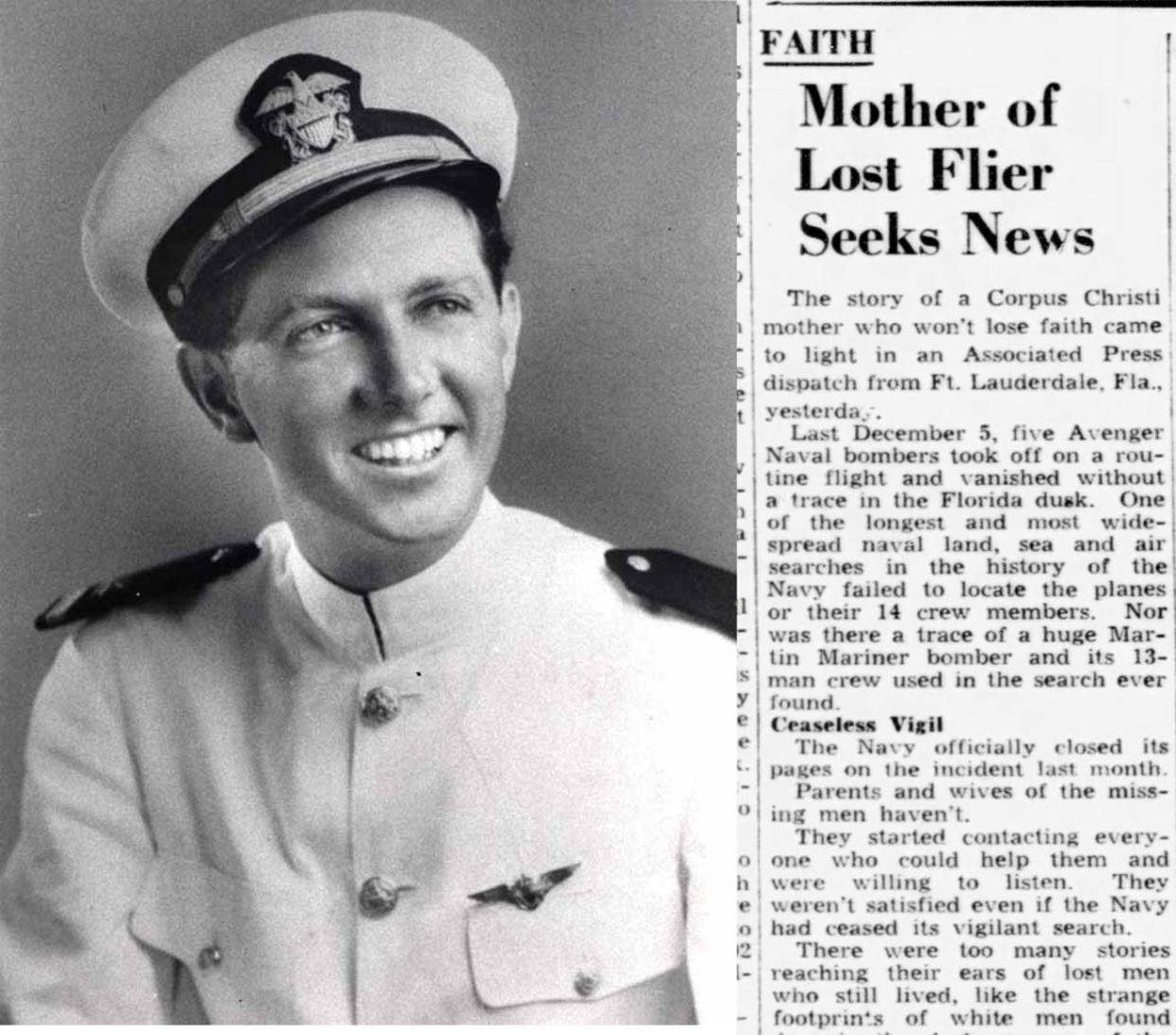#TBT: How Corpus Christi family's tragedy started the lore of the Bermuda Triangle

Corpus Christi is a long way from the so-called Devil’s Triangle. But for one local family, a tragic disappearance became inextricably linked to the lore surrounding the Bermuda Triangle.
On Dec. 5, 1945, instructor Lt. Charles Carroll Taylor led a squadron of five TBM Avenger torpedo bombers for what was considered a routine overwater navigational training flight out of Naval Air Station Fort Lauderdale. The weather was considered normal, with a few scattered showers, and the first leg of the exercise was completed with no trouble.
Charles Taylor was born in Corpus Christi and graduated from Corpus Christi High School, then attended Texas A&M University in College Station. His mother, Katherine Taylor, was a longtime schoolteacher, and Charles Taylor was a favorite of his maternal aunt, Mary Carroll, the first female superintendent of Corpus Christi Independent School District.
Charles Taylor received his wings at Naval Air Station Corpus Christi in April 1942 at 23 years old, and was the first native Corpus Christian to receive his wings at the new naval air station, completing the training less than a year after enlisting in the Navy. For the next six months following his graduation, he served as an instructor of intermediate flying out of Cuddihy Field, then in 1943 began flying anti-submarine patrols over the Caribbean Sea. He then served in the Pacific Theater, flying numerous bombing missions. He returned to the U.S. in 1945 and was stationed in Florida as a torpedo combat training instructor over the Caribbean and Gulf of Mexico.
More:#THROWBACK: Did La Lechuza terrorize Robstown in 1975?
Reports on that fateful day have varied through the years, but most reports — including the official Navy report — agree that somehow the compass equipment of Charles Taylor’s plane, along with at least one of the other training planes, went out. The flight crews struggled to determine their position via sight, with Charles Taylor assuming they were over the Florida Keys. According to many researchers who've studied the records, the planes were actually over the Bahama Islands. Flying northeast took them out in the Atlantic.
In the last message Flight 19 sent before communication was lost, Charles Taylor was heard saying, “All planes close up tight … we’ll have to ditch unless landfall … when the first plane drops below 10 gallons, we all go down together.”
Numerous planes and ships were dispatched after officials realized the planes were off course and communication was lost. Naval and merchant planes and boats kept searching for the missing planes. Two PBM Mariner flying boats attempted to locate the planes that evening, but one disappeared off the radar and a passing merchant ship later reported seeing an explosion and oil slick in the same area.
In all, the five planes of Flight 19 and its 14 personnel and the PMB Mariner with its 13 personnel were never recovered. The Navy officially called off the search on March 8, 1946.
“The Navy may have closed the chapter,” Katherine Taylor said in an interview that month, “but I haven’t.
“It just can’t be possible that so many could disappear without a single clue. I shall never give up until I find out why.”
Katherine Taylor even posted a $1,000 reward for information leading to the recovery of her son. When the naval inquiry came back faulting Charles Taylor of “temporary mental confusion” and “faulty judgment,” Katherine Taylor and Carroll began their own research. After writing more than 200 letters and conducting 48 interviews with people involved, Katherine Taylor eventually brought her information to the Board for Correction of Naval Records in 1947, who agreed to have Charles Taylor cleared of personal blame in the disappearance.
More:#TBT: The carousel in Padre Staples Mall delighted riders for two decades
And back to the Bermuda Triangle connection. Flight 19 often turns up as the first recorded incident of an aircraft disappearance in the Bermuda Triangle. Interestingly, you don’t see the phrase "Bermuda Triangle" being used in news stories until 1950, as the legend of the mysterious disappearances of airplanes and boats grew into the public consciousness.
In 1975, reference librarian Larry Kusche released his book, “The Bermuda Triangle Mystery Solved,” with a chapter about Flight 19. Kusche, with experience as a commercial flight engineer, delved deeper into Flight 19 with his 1980 book, “The Disappearance of Flight 19.” He traveled to Corpus Christi to interview Charles Taylor’s sister, Georgia Lowe, and her husband, Whitney. The Lowes had a box of material and research Carroll had compiled and saved. Carroll died in 1971 and Katherine Taylor in 1973. The documents revealed the extent of the fight the two sisters had with the Navy until they eventually gathered enough evidence to clear Charles Taylor’s name.
Kusche explained in his book how the disappearance gave rise to the Bermuda Triangle lore.
“The accounts of Flight 19 that appeared in the newspapers at the time were largely inaccurate. By the time the facts were sorted out, the incident was old news and not given much space.
"Years later, when the public interest rekindled, many writers began to tell ‘the story’ of Flight 19. If these writers did any fact-checking at all, it did not go beyond these original unreliable articles.
"They repeated whatever they found and filled in the gaps with conjectures, often of the wildest sort.
"Then along came the next writer, and the next, until some 30 years later the account had evolved into a tale of premonitions, mysterious messages, occult forces, UFOs, time warps and other surefire elements of the sensational story.”
Allison Ehrlich writes about things to do in South Texas and has a weekly Throwback Thursday column on local history.
This article originally appeared on Corpus Christi Caller Times: How a Corpus Christi family was tied to lore of the Bermuda Triangle

